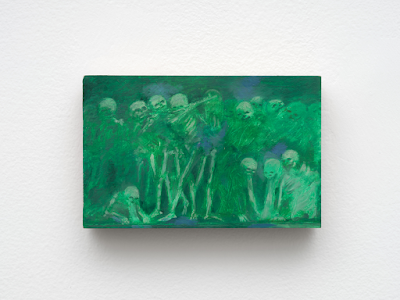Unlife: Part II at Soft Opening
In the Gregorian New Year, when December's misery daubed in glitter is replaced with a slightly varied flavour of misery under grey skies, drizzly rain, and refreshed self-loathing in the form of diets and exercise regimes being marketed from all angles, it is a bold move to drag oneself to an exhibition entitled Unlife. Part one of the series was hosted at Paul Soto in Los Angeles, a city that certainly is burdened with the same issues as London, but, at least meteorologically, experiences them through a different lens. There is arguably less pathetic fallacy at play in the sunshine.
Its East London continuation does not provide an uncritically melancholic outlook; that would be almost too easy. Unlife: Part II has been curated by the LA-based artist Maren Karlson, and takes the seventeenth century painting, Et in Arcadia Ego by Guercino, as its point of departure. Much like the exhibition, whilst the painting features a skull as a focal point of interest, it is not merely straightforwardly melancholic, nor is it hopeless. Without being facetious or glib, clutching to hope is a key feature of surviving the 2020s apparently, so it is apt to see it presented through an exhibition. Back to Guercino, and the two shepherds depicted in his painting, now over four hundred years old, look wistfully in the hope of a "pure, uncontaminated utopia", which is conveyed well by the text accompanying Unlife: Part II.
A fear of inpurity and contamination is the essence of many of the social and political struggles we contend with today. That of ageing and death seems to be comparatively shallow when considering the more acute fights, such as xenophobia and anti-migrant rhetoric, genocidal activity, Imperial land-grabs, and climate catastrophe (none of which are mutually exclusive). However the topic of death, in its most basic sense, and the perennially challenging, and fluctuating, degrees of acceptance we may or may not experience, are fundamental to our understandings of 'self' and 'Other'. This is not to say we can, or should attempt to, feel acceptance towards injustice and unjust killings. While there is a level of mental gymnastics involved in getting there, when we acknowledge ourselves as non-individuals and collective in our mortality, we inch closer to acting with care and empathy.
Alas, as is always the case, we must cast a critical eye as to whether an exhibition in a commercial setting has the wherewithal, nay the guts, to execute these ideas in a way that is remotely tangible. There are certain moments whereby the curator's ideas are beautifully played out, mostly thanks to the inclusion of artists Brooke Hsu, Jasmine Gregory, and Martin Wong. There is a gorgeously rich text by artist TJ Shin among the list of works, and their assertion that the use of the skull in Guercino's original painting presents a "paradoxical entity of "with-without", "life-nonlife"... is an affirmation of the spectral gaze that allows the experience of ungrounding" is mirrored in Hsu's work. Skeleton bodies come together in pursuits of leisure, and we are forced to view this in contrast to the ways skeletons, which we physically are, have been depicted through both horror and cartoons. They are not an evil danger to us, they are us, we have always been them and they have always been us.
Elsewhere in the space, transformations and alchemisations around purity and detritus are shown irresistibly through the work of Zurich-based Jasmine Gregory, whose sculpture Own Nothing and Own Nothing evokes the aesthetics of a senseless waste, to almost comic effect. There is something very Gen Z about the work, equal parts glam and despair. To entirely misquote Tyra Banks, "garbage, but make it fashion!"
Not every inclusion is an initial lightbulb moment for the viewer in terms of keeping up with the theme, but each work is granted a great amount of space to showcase itself, and for the viewer to get as close as is appropriate. Gregory's work depicts the inevitable detritus potential of everything, whether the object is deemed productive, useful, something in between, or none of the above. More importantly, we are forced to reckon with our treatment of materials; whether they are a Prized Artwork, a discarded piece of packaging, or indeed our own bodies, everything bears the same fate.
A similar affect is produced in the late Martin Wong's painting, Untitled (Arcata Town Plaza). The state of materials as waste-to-be is less obvious here, yet the almost suffocatingly warm palette used in the painting is reminiscent of forest fires blighting the environment and changing the hues of the sky for thousands of miles, and the resulting disfiguration of the landscape. Somehow, this work feels so much more personal; Wong's contribution to the Hippie movement in the 1960s and experimentations in sexual freedom and psychedelic drugs may be observed in the painting, with disorienting effects and realism working in tandem. Yet, the location certainly meant something significant to the artist; Wong was known to have said, "everything I paint is within four blocks of where I live, and the people are the people I know and see all the time." (1) Indeed, Arcata Town Plaza in California is a mere 14-minute walk from Humboldt State University, where Wong graduated in 1968. Ultimately, viewing Untitled (Arcata Town Plaza) feels like a challenge, whereby we recognise motifs but cannot tell the full story.
Perhaps the narrative is part-alive, and part-dead, as all ideas always are, and as we always will be.





